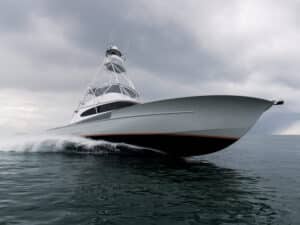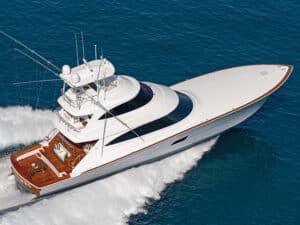
Viking 74 main page
I’d bet that precious few of you ever ran a Viking before the Healeys owned the company – back when Vikings were carvel-planked, wooden convertibles. You honestly can’t compare today’s Vikings with those from the old days, but this new Viking 74 is so much more innovative than anything else the Healeys have done, I’m not sure you can compare it with any of their recent models either. Perhaps the best word to sum up the Viking 74 is “utility.” You can do whatever you want with this boat. Long-range cruising, big-game fishing, nearshore fishing, live-aboard … no matter what you want to do with your 74, it’s all good with this addition to the Viking family.
**Performance
**One thing the Viking 74 can’t do is change the weather. At 4:30 a.m. the southeast wind in New Smyrna Beach on central Florida’s east coast already held steady at 15 knots with gusts to 25. Thanks to heavy clouds and rain, not a star shone in the sky. Not great fishing conditions, but perfect for a test.
Idling up the Intracoastal Waterway to Ponce de Leon Inlet, I found the 74’s slow-speed steering amazingly responsive and effortless. Once out the inlet, the Viking 74 took 10 seconds to plane. Seas of 3 to 4 feet kept me from firewalling the throttles right off the bat, but cruising at 28 knots with the seas on the starboard bow offered no challenge. And thankfully, at cruising speed the flybridge remained remarkably quiet.
Running up-sea or down didn’t seem to matter to the 74: It tracked smoothly and quietly on all points, even coming home at 30 knots in quartering, down-sea conditions. When I turned the wheel hard over, the 74 leaned into the turn, carving a four-boat-length arc with aplomb. It was almost a nonevent.
One brilliant innovation – the use of three trim tabs – makes attitude adjustment a cinch. One tab on centerline raises and lowers the bow, while the outboard tabs control port and starboard trim.
Fishing turned out to be a tad slow on test day. We caught one miracle – a 50-pound wahoo on 20-pound test with a 60-pound mono leader. The hook lodged right in the corner of the fish’s mouth, avoiding the razor sharp teeth. We also managed to catch and release a beautiful 65-pound sailfish in a matter of minutes.
Conclusion? This boat has no problem raising (or catching) fish. In addition, I managed to get the 74 up to 7 knots in reverse before any water came over the transom.
Even though 74 feet constitutes a considerable bulk to whip around, a good skipper shouldn’t have any problems keeping up with a spirited billfish on the string. The innovators at Viking designed foot controls for the bow thruster that the helmsman can use while facing aft and keep both hands on the gear levers. The boat spins acceptably with the wheel and gears/throttles, but add the thruster to the mix and the boat pivots like a 35-footer.
Back in the waterway, I pinned the throttles to hit a 36.8-knot top speed at 2,350 rpm burning 196 gph. That’s moving right along for a boat of this size.
**Flybridge
**You can’t help but notice the immense size of the flybridge. At the same time, when standing at the helm you quickly get a feeling of being at home. The ergonomics work well, and the layout provides excellent visibility with all electronics within easy reach.
Ergonomics dictated a sizable scallop carved out of the flybridge’s forward brow to afford the helmsman a much-improved view of the foredeck (back to the second stanchion when seated). For the captain to see the cockpit from the helm, the wheel must be pretty far aft on the flybridge, hence the scallop forward. The helm station also sports a 3-inch-high platform to stand on. I’m sure that Viking will work with owners to determine the correct height for them. Facing aft while backing down, I could see everything aft of the back half of the fighting chair, including both corners and the stairway coming out of the salon.
Being notoriously safety-conscious, I always look for handholds and found plenty in perfect spots to help you move around the flybridge in rough weather.
Accessing the one centerline helm seat or flanking companion seats was a breeze, thanks to plenty of room behind the flybridge hatch. You won’t have to disturb the captain to get to your seat.
A drop-down electronics box in the overhead augments the twin console boxes, while a vast clear-acrylic-encased dash houses all the displays. Most of the instruments aboard this Viking consisted of black-box systems viewed on VEI 15-inch sunlight-viewable displays. The starboard console box on our test boat contained an ICOM ICM602 VHF radio, control box for a Furuno FCV1200L sounder and the searchlight control, as well as the Audiovox XM radio and KVH Tracphone. The matching box to port hides controls for the Lewmar bow thruster and the Furuno 98-mile radar, along with an ICOM ICM802 single side band and another ICOM ICM602 VHF. Flush-mounted in the dash right to left you’ll find a 15-inch VEI sunlight-viewable display for radar, Nobeltec, Weather Channel and Hot Eye infrared night vision, a Northstar 1202, Northstar 962 and another VEI display – also showing Nobeltec Navigator, Weather Channel Marine and DirecTV.
To round out the electronics suite, Viking mounted a Northstar 6000I repeater and a Furuno RD30 data display up in the tuna tower. I must add that the installations were excellent, thanks in large part to Viking’s Atlantic Marine Electronics division. Likewise, another division – Palm Beach Towers – fabricated the tower and buggy station atop the 74.
Forward of the helm station there’s enough room to play a rousing game of half-court basketball. Two long, straight settees hide rod storage, and a long forward-facing bench occupies the front of the console. This area is huge.
Because of black boxes, you get more storage inside the console without the clutter of electronics. There’s yet another freezer, a sink and a drink box on the flybridge, too. Viking puts a hidden reel with a 50-foot washdown hose up here as well.
**Engine Room
**Full, standing headroom came as no surprise in the engine compartment. Viking situated the compressors, Eskimo ice maker and generators along the aft engine room bulkhead; pumps and the like are mounted forward. A fuel-polishing system affords peace of mind if you happen to take your boat to some of the more remote places in the world, while the Delta-T ventilation system assures that the engines always get the right amount of salt-free air for optimum performance.
These vents also have dampers that automatically close to restrict ventilation when the fire-extinguishing system is activated. This prevents a flare-up by filling the machinery space with extinguishing chemicals until the fire is out.
Another terrific innovation helps with emergencies. Most boats have crash pumps that recruit the engine cooling system pumps to help with bilge-pumping duties. On the 74 those same engine pumps can operate from the forward and aft lazarettes as well.
I particularly liked the addition of sliding trays that make changing out or maintaining your batteries much easier on your back. And finally, as a salve to curmudgeonly types like me, Viking installed a separate sound system with speakers in the engine room, so if your crew likes to listen to rap or heavy metal while maintaining the power plants, you don’t need to join the house party.
**Cockpit
**Admittedly, 218 square feet qualifies as a huge cockpit. In fact, without the offset on the gorgeous Murray Products fighting chair, you’d never get a rod tip past a cockpit corner without switching over to surfcasting rods. The Murray chair is quite a fishing tool itself, with six rocket launchers, a rigging tray and tackle drawers in addition to the pure, aesthetic beauty of it.
Overall, I found the cockpit remarkably easy to work. And in keeping with the current trend on boats this size, a considerable mezzanine runs across the forward end, providing mammoth amounts of storage in addition to a hidden grill with drawers beneath.
The transom holds a large, deep fish box that augments the in-deck fish boxes/livewells. The cockpit gunwale’s lowest point comes to just above my knee – a perfect height for bracing yourself without being in the way. More innovations like gaff tubes under gunwales, built-in chamois storage tubes and a concealed oil-change pump fitting in the mezzanine locker to starboard abound. In fact, you’ll find hardly any unused dead space aboard the Viking 74. Oh, there’s more freezer space and storage under the mezzanine as well.
Being a traditionalist, I’ve always considered air conditioning in a cockpit as something for sissies – until now. The difference between sitting in a comfy seat on the cockpit mezzanine with air conditioning and cool-misters and sitting on a gunwale during a hot, muggy day proved a dramatic enough change to alter my thinking on this one.
**Interior
**I love that Viking has gone back to traditional teak joinerwork. It’s more tasteful and “yachty.” I didn’t see an unfinished surface anywhere aboard the boat. From the painted engine compartment to the flawless brightwork of the interior, this boat showcases Viking’s impeccable workmanship.
The living area of the salon is very comfortable, with a huge L-shaped settee to starboard (loads of storage under) facing the entertainment center to port. Three bar stools line the galley’s island counter. However, the dinette seats only three or four.
The galley sports granite countertops, refrigerator and freezer drawers, and every amenity and appliance known to man. At the top of the stairwell to belowdecks is a day head. I love the concept of not needing to go down below during the day. But, I would prefer the day head to be at the aft end of the salon or out on the mezzanine rather than on the forward end so people don’t track water or worse through the salon. Viking wisely multitasks this head, though, building an adjacent compartment that houses all the black boxes for the myriad electronics aboard. It’s a great way to keep all the delicate stuff out of the flybridge console and the weather, as well as offer a much easier place to work on it.
The starboard-side curved stairway to belowdecks leads first to the exceptionally nice crew’s quarters (down a secondary flight of stairs). Continuing forward on the guest level, you come to the portside master stateroom with a beautiful head and large hanging locker. Go still farther forward and you start having to make choices; the five-guest-cabin layout has port and starboard compartments with over/under bunks. The fifth large stateroom in the fo’c’s’le boasts either a queen-sized island berth on centerline or a double to port and a single to starboard. The four-cabin version eliminates the starboard over/under accommodations.
Interestingly, this Viking presents two different window profiles, depending on whether you’re looking from the inside or the outside. Inside, the windows look rectangular and traditional, while outside you see only the dramatic, stylish rake.
In keeping with this boat’s making more and better use of dead space than any Viking I’ve seen, you’ll find storage along the length of the curved, starboard-side companionway below.
What more can I say? Anyone would be stoked to own a Viking 74.







